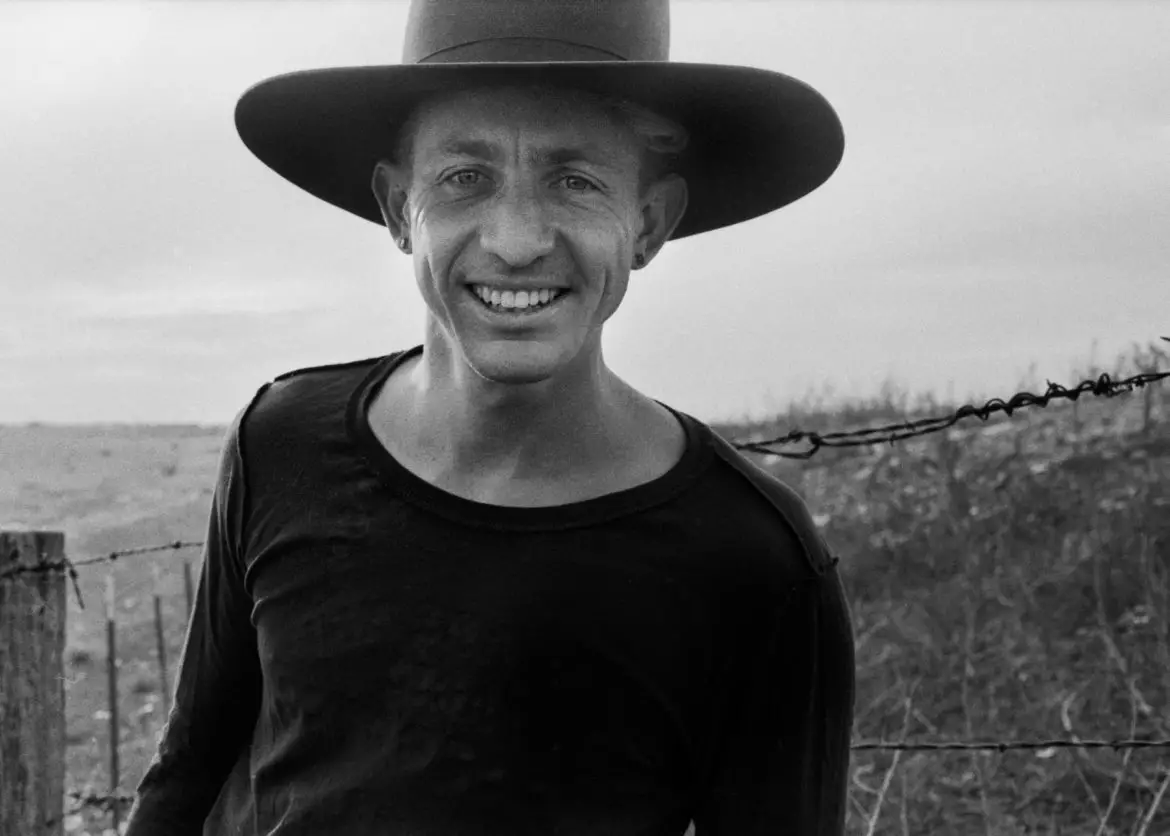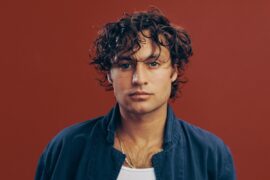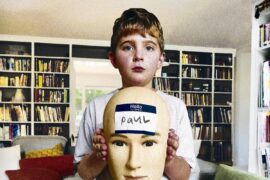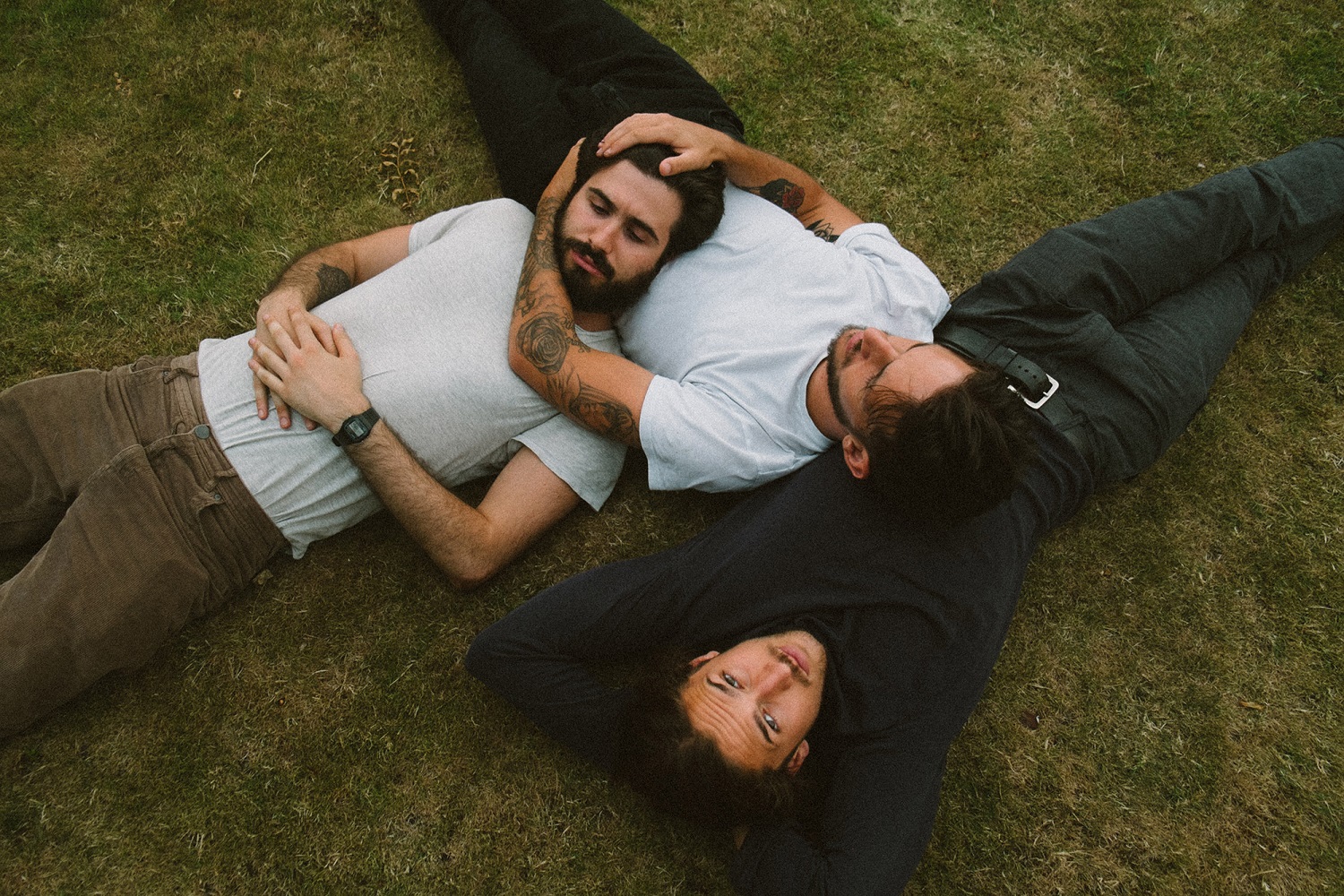Coinciding with the release of his second solo album ‘Two Saviors’, Buck Meek gives an insight into his methods of storytelling, spreading authenticity, and recording in a house with the presence of ghosts.
•• ••
Stream: ‘Two Saviors’ – Buck Meek
Some styles of music have distinctive qualities that immediately transport us to vivid places. With Two Saviors, the second album by Buck Meek (released January 15), it feels like late spring/early summer in the wilderness, sleeping in a wooden cabin, bathing in a lake, and laying on the grass watching the clouds while thick greenery surrounds us. Picnics of simple sandwiches and snacks are taken while having daytime walks up the mountains and leisurely strums of an acoustic guitar are made while sat by the aforementioned lake. If you’re living in a wintery part of the world right now and trapped in your home with no ability to go adventuring, Two Saviors is ideal escapism.

The opening track, “Pareidolia”, encompasses this mood, exuding innocence and whimsical reflections. While the title refers to the playful misconception of things, seeing patterns and objects in objects unrelated, it also kind of relates to the album’s concept. The songs flow with ease and happiness but they were born from a transitional period of pain. They also have an air of refreshing warmth and a simplicity as though created in a cabin in the woods but were instead recorded during the hottest time of the year in an old house in New Orleans, the sweltering heat wrapping itself around the instruments. The days were structured: breakfast, a few hours of recording, long siestas until the temperature cooled down, then a few more hours of recording. It was, however, created with a naturalness, the first or second take of the songs (done on an 8-track tape machine with limited equipment and no headphones) used as the final one to not allow overthinking and polished perfection
Pareidolia, with your head upon my lap on the buffalo grass
The clouds are moving fast
Sippy tell me what you see
“Maybe it’s a baby
Maybe it’s a cottonmouth swallowing its tail
That one that looks like lady Guadalupe with an airplane in her hair”
It’s a paradise
The sun is just a glow
Though shade your eyes
There goes a phoenix with the last light
– “Pareidolia,” Buck Meek
Buck Meek is known as a member of Big Thief, a band recognizable for delivering sweet and sombre emotions through their songs, and Two Saviors is a follow-up to his 2018 self-titled. Like that first solo album, Two Savoirs is centred around characters. It’s hard to uncover what’s real and what’s fictional when the lyrics are driven by narrative. ‘“Race you down to the well” said Sue/ “Last one surrenders their family jewels”/ “You’re quick, but Hunter I am too”’ goes “Cannonball! Pt.2”, Meek’s country lilt warbling over twangs and jam band-style melodies. ‘Slow dance, romance/ Come on Joe, it’s your last chance/ and she won’t catch you, man I’d bet you/ She won’t catch you when you fall’ goes the title track, a slower, sparser moment on the album. ‘Save me half of that sandwich Annie/ I haven’t eaten since 1999/ It’s a miracle I’m alive/ Please spare my life with ham on white tonight’ goes “Ham on White,” vocals trailing in pitch before a harmless eruption of guitars and drum crashes.
While pain and healing aren’t often explicitly referenced, we can sense it in the details. For example in “Pocketknife” (‘Maybe August 29/ if I make it through July/ Thank god for coffee and apple pie’), a song accompanied by the sound of a fiddle that’s like the blowing of a gentle breeze, and “Candle” (‘When it’s too much to handle/ burn me a candle/ and when you don’t have a candle/ let me burn in your mind’), co-written with Adrianne Lenker. In the closing track, “Halo Light,” Meek remarks ‘Though all our love remains/ so why do we feel sorrow?/ Pain comes in seasons departed/ Our bodies left alone/ All our love with stay/ To live again tomorrow,’ finding the light and renewal in more emotionally draining situations.
Whether it’s the lyrics or ambiance of the music, creating an alternative life through storytelling, memories, and the imagination feels at the core of Two Saviors. Coinciding with the release of the album, Atwood Magazine spoke to Buck Meek about this approach to songwriting as well as the intriguing recording process.
•• ••
Watch: “Candle” – Buck Meek
A CONVERSATION WITH BUCK MEEK

Atwood Magazine:When listening to the album Two Saviors for the first time, I was immediately transported to a cabin in the wilderness in late spring with a lake and mountains and lots of greenery. I then dove into the context of the album and, while it wasn’t recorded in a setting like this, there does seem to be a prominent air of simplicity to it: recorded in 7 days with little equipment and just one take for each song. Did you have this recording process in mind when you were writing the songs? Was it something you wanted to set out to do from the start?
Buck Meek: The idea to record the album in New Orleans in seven days with an 8 track with only dynamic microphones and no headphones was my friend Andrew Sarlo’s idea. I asked him to produce the record and his suggestion was that we do it as quickly as possible and just to tap into our subconscious and not be too precious and let the songs speak for themselves from the heart. I wonder why he had that idea. Maybe because the writing of this album was pretty cathartic for me over the course of a year or so of transformation so perhaps he wanted to counter balance that with a more immediate recording process.
Atwood Magazine: Mmm because I read that but then I wasn’t sure if you had asked him to record it on those conditions or he asked you.
Buck Meek: Yeah that was his idea.
Atwood Magazine: That's fun. This also took place during the hottest time of the year. How did this effect the process? I wonder to what extent the recording reflects the mood of the songs because there’s a real warmth when listening to them.
Buck Meek: Ohh yeah. With humid hot weather in New Orleans, the instruments love it. Because instruments are still trees. Of course they’ve been pulled out of the ground and made into thiner pieces of wood but they’re still trees and have grain and pores and they love the humid weather. Everything’s running a little hotter, the tape’s probably a little goopier and stretchier and everything’s overheating just slightly which maybe causes an extra distortion. Plus everyone’s brains are a bit fried from the heat, which overall means there’s a little less clarity and lucidity than what you would find on a crisp fall day. I think with that you maybe lose some of the self-consciousness that comes from having too much self awareness and you just tap into your bones and instincts.
Atwood Magazine: I love what you said about the instruments being like trees. I’ve never thought of it that way but it makes them seem like they have a life of their own which is really sweet.
Buck Meek: Yeah, they do and I think they take on the life of their players. Also just with heat like that, things blend together and melt into one another. As a group playing music in a room in an old home, we have to turn the AC off to record. I think everyone’s pysche blends together in heat like that.
Atwood Magazine: The opening track, “Pareidolia”, has an innocence to it and again kind of represents that mood of carefree days out in the sunshine, this time gazing at the clouds. The word refers to misperceptions of things. Is this a theme throughout the album and if so could you give some examples?
Buck Meek: The definition of pareidolia for me is our instinct to interpret stimulus in whatever form it will come- To reinterpret the shape of clouds into a symbol or to reinterpret some archetypal story into a religion. I think even the title track “Two Saviors” pulls something from that, just our tendency to deepen our spirits through meaning through projecting our own stories onto others and other stories onto our own. And really just through a process of finding understanding.
Atwood Magazine:Yeah because you say in the press notes that writing the songs was ‘a process of creating talismans - little prayers and visuals from within the constant flux of pain, healing, and discovery.’ Were these personal emotions and, if so, how do you go about translating them into music? Because your songs always have a very traditional storytelling element to them, like they’re very character driven I feel.
Buck Meek: With this record I really tried to be as honest and confessional as I possibly could. I was going through a transformation as we all do and trying to document that process almost as a journal without necessarily relying on the literal experience but more trying to document my emotional process in whatever abstractions and whatever associations arose in me. And often just through my observations if I was experiencing something while observing nature or a form of nature. Of course as a human soul I would attach myself to that in some kind of way. Long story short I was trying to document my experience without having to explain it to myself.

Atwood Magazine: You said that this came from a personal transformation. Did you write the songs after as a way of reflecting or did you write while you going through the transition in order to make sense of it?
Buck Meek: Those two things are always overlapping. It’s a snake eating its tail.
Atwood Magazine: That’s true actually. In the songs you mention a lot of names, and this is the same in the past too. Do they come from real people? How fictional are the narratives?
Buck Meek: Some of them are real nicknames for people in my life and more or less all of the names are at least altaegos for someone in my life. Sometimes I put multiple names on one person in my life. Long story short again I feel committed to certain characters since I almost feel a kind of duty to recognize these characters through my own personal development. Almost as archetypes in my own development and to observe them grow and die and also to interact. These characters that I would create or reflect upon in my own storytelling, I also love to introduce them to each other and try to observe the magic and reactions that they have with each other that I couldn’t necessarily predict.
Atwood Magazine: I love that! One song that instantly stood in my mind was “Ham on White” because the idea of a ham sandwich on white bread is so basic and timeless. I don’t want to say old fashioned but it makes me think of like a time when grandparents are young. There’s also something about your vocals in general that have a kind of nostalgic quality to them. This song, however, feels more forceful than the others- the instrumentation is a little heavier and there’s desperation in the lyrics. What is the significance of the sandwich in the song, if there is one? Does it represent anything?
Buck Meek: The significance of what?
Atwood Magazine: Why a ham sandwich.
Buck Meek: Oh a ham sandwich. Good question.
Atwood Magazine: I mean it could not mean anything. I could have just been approaching it too deeply.
Buck Meek: No it’s perfect. I haven’t thought about that ham sandwich so much but I think you’re on to something. I think what it was was just trying to explore the idea of the simplest objects being the centre of the most complex human relationships. We can channel all of our layers and complexes and relationships into one simple ham sandwich. Almost like some planetary system revolving around this ham on white bread with all these various gravitational forces and celestial bodies and human emotions mixed up and hyperfocused on this ham sandwich.
Atwood Magazine: Haha. Speaking of food, I understand there was a lot of structure to the recording process of the album. You would have breakfast, record for three hours and then take a siesta. I think I remember in a past Big Thief interview that the band said that when making albums food is a big part of this. I don’t know if it was the same for this but what did your breakfast consist of?
Buck Meek: We were making a lot of breakfast tacos, as always. We had a big pot of beans on the cooker. Mostly just coffee and breakfast tacos.
Atwood Magazine: Yum. Could you talk about the location a bit more, the house you were in.
Buck Meek: My friend Stacy has this incredibly victorian home on the corner of Royal and Desire street in in New Orleans’ Bywater Neighbourhood. It’s this beautiful white Victorian home with a wrap around porch and immensely tall ceilings. It’s only a one story house but the ceilings are so tall that it feels much bigger than it actually is. I think she actually rents this home as an inn for anyone passing through New Orleans. She also makes these incredibly watches from old swirly bakelite plastic that’s reminiscent of those gel watches with elastic that we would wear in elementary school but super fine. Her company is called Time Will Tell.
Atwood Magazine: Time Will Tell. Cool, I will check that out!
Buck Meek: The house is really special and filled with antiques and unicorn skulls and Victorian lingerie and lots of velvet.
Atwood Magazine: That’s amazing.
Buck Meek: And it’s haunted; There are a few ghosts that live there- One in the bath tub and another on the porch. Yeah it’s a really special place.
Atwood Magazine: What were the experiences that you had with the ghosts if you had any yourself?
Buck Meek: Well the only thing that I really felt was on the porch. On the front porch there’s this spot where Stacy would make us stand and you feel the steps have this increase in gravity. It feels like it’s sinking in and she tells you that the original owner of the house was murdered there on the porch, I believe by his wife. I felt it.
Atwood Magazine: Whoa, that’s so funny.
Buck Meek: It’s called Wonderland. You can look it up.
Buck Meek: Yeah, it was a conversation. My goal is to simplify as much as possible, try to remove the reflection from the process, just take that weight away from ourselves and removing the headphones to limit our time because we only had one chance to play the song in the morning and then another chance in the evening. So we just tried to tap into our instincts. The first record was a lot more deliberate but also a really beautiful process. I worked with my friend in New York beneath the Lower East Side in the winter time, very cosy. We kind of moved around New York City over the course of a winter which was just by necessity at the time. We were all very busy and kind of dispersed, just taking every chance that we could to finish the record. But it’s exhausting to spread things out like that. I wanted to do something simply and correctly. Just trust the players.
Atwood Magazine: Who did you collaborate with for the making of this record? I guess you had to have a lot of trust in them if you wanted the first take to be the one you could keep.
Buck Meek: Yeah, exactly. I think most of it was just having trust with my band. We’ve been playing together for around four years now, we’ve toured so much since our first record and I just have such faith in their ears and their hearts. They’re just such sharp players and so wild and whily and willing so I just love the idea of hearing them improvise and react and to create a limitation where everyone has to listen with their ears wide open. That’s just the most exciting thing to hear, when nobody has time to think. So all the players on the record, Adam Brisbin on the guitar is my guitar hero. Austin Vaughn on the drums and Mat Davidson on pedal steel and bass and fiddle. And my brother Dylan meek on piano. All just total wizards.
Atwood Magazine: That’s so sweet. This is your second solo album but how does your mindset differ when working solo compared to in Big Thief? What is it you hope to project for the listeners?
Buck Meek: With my solo project I suppose I just feel this different sense of responsibility as a storyteller. I think it’s a pretty sacred thing to guide someone through a story and I feel a sense of responsibility to tell the truth and be as genuine as I can with myself. It’s therefore very vulnerable but also so freeing. With Big Thief it’s so different. I’m part of this collective spirit where I think we all enter the space together and form a new identity entirely. There’s something more forgiving about it for me because I’m more on the sides, just guitar and contributing my vocal harmonies. More on like a supportive role or living in an ambient instrumental space. So there is more room for me to reinvent my identity in a more improvisational way and completely enter a new character. Whereas in my solo project I feel more of a responsibility to be myself.
Atwood Magazine: For sure and I think you succeed with that. I think the album has come at a really perfect time. I was listening to it over Christmas and then obviously at the start of the new year in preparation for this and it’s so sunny and easy-going that it gave me some positivity when entering the new year even though things are far from happy for me right now. I don’t really want to talk about Covid Times because it’s a really obvious thing to ask artists about but is songwriting a kind of escapism for you? When you’re writing do you find yourself drifting into the worlds or snapshots you’re conjuring up and, if so, I don’t know whether you’ve experienced periods of isolation but if you have has songwriting been a good remedy for any loneliness?
Buck Meek: Yeah, so much. That’s a big part of it for me. Just painting my own picture. During Covid I’ve actually written a lot to create new spaces for myself through song.
Atwood Magazine: That’s cool. I feel like there’s been two sides to this: There’s some artists who can’t create at the moment because they lack the drive and need to ‘live’ to gain the inspiration and then others who are just using this time to be really creative and let things out.
Buck Meek: Yeah I think we’ve all lived enough if we dig deep enough. There’s going to be something there to write about. In the words of my friend Jolie Holland, you need to just chain yourself to the piano. We’ve all lived plenty of life.
Atwood Magazine: I can imagine. Similarly are there any other artists you feel are particularly good at writing narrative-driven songs that you can listen to and immerse yourself in like you would if you were reading a novel, for example?
Buck Meek: Oh yeah. Let’s see. Like specifically narrative driven songs?
Atwood Magazine: Yeah, just people who are really good at telling stories through their songs and you feel yourself being sucked into that world.
Buck Meek: Oh yeah. I love John Prime for that. He creates such vivid characters. I love Townes Van Zandt for that as well. And Michael Hurley is one of my favorites.
Atwood Magazine: Awesome! Finally, Two Saviors is here at the start of the year. Nobody can make plans for the following months but do you have things in mind you hope to do to coincide with this album?
Buck Meek: Yeah I wish we could tour but we I think we’re going to put out a streaming concert, like a pre-recorded streaming concert at some point in early spring. We’re still holding on to some dates for end of the summer in the UK and Europe including End of the Road, if that’s not cancelled. So that would be the first tour that we go on for this record hopefully in August, I believe.
Also my dear friend Steven van Betten of the band Kidi Band and Fell runner has built this incredible educational website called School of Song and it’s like a group lessons. I’m going to be teaching probably songwriting and guitar lessons on School of Song in the spring alongside Molly Sarlé and Steven and a handful of people in our community. I think it’s going to be a really special resource for people to learn in a non traditional way.
Atwood Magazine: That’s amazing. Do you know how many sessions you’ll be doing?
Buck Meek: Steven’s idea for it is that it’s going to be a rolling thing – a touring musician or songwriter could just on a whim put a course, usually like a month long course. 8 lessons. 2 lessons a week for a month or so. But the format of the website will allow musicians and songwriters to come in and out inbetween tours. The focus will be on real working musicians.
Atwood Magazine: It's a really good idea, especially because it's so inspiring to get into the headspace of an artist. Do you know how much it will cost?
Buck Meek: It will be really affordable. We don’t have an exact price yet but it’s going to be very very affordable for what you get. That’s the whole idea that you will get a group lesson that’s still very valuable for everyone but it will be like a fraction of the price that a private lesson will cost.
— —

Connect with Buck Meek on
Facebook, Instagram, Twitter
Discover new music on Atwood Magazine
? © Robbie Jeffers
:: Stream Buck Meek ::








